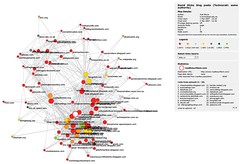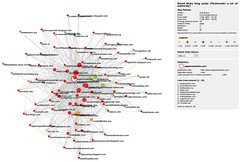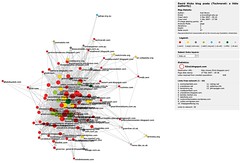Leeds. I'm really quite happy with the way that my first real attempts to use the IssueCrawler tool to map the Australian blogosphere have turned out. As I've mentioned here previously, I'm currently exploring this tool as a means of tracing how particularly topics are discussed across the distributed and ad hoc networks of blog-based conversation, and I used the case of Australian-born Guantanamo Bay detainee David Hicks as a case study - with renewed calls for the Australian federal government to urge the Bush administration to finally bring Hicks to trial or release him (he was captured in December 2001, but has not been charged yet), there was increased discussion about Hicks's fate over the last couple of months, and I've been interested to see how this has played out in the blogosphere.
I'm really quite happy with the way that my first real attempts to use the IssueCrawler tool to map the Australian blogosphere have turned out. As I've mentioned here previously, I'm currently exploring this tool as a means of tracing how particularly topics are discussed across the distributed and ad hoc networks of blog-based conversation, and I used the case of Australian-born Guantanamo Bay detainee David Hicks as a case study - with renewed calls for the Australian federal government to urge the Bush administration to finally bring Hicks to trial or release him (he was captured in December 2001, but has not been charged yet), there was increased discussion about Hicks's fate over the last couple of months, and I've been interested to see how this has played out in the blogosphere.
So, my work on this was meant both as an exploration of the methodology for and proof of concept of using IssueCrawler in this context. Overall, I think this has worked pretty well, and I've begun drafting a paper to discuss my approach in detail (most of this was written while waiting around airport lounges during my rather circuitous trip to Ibiza and back last week, incidentally). This first research project is part of my wider work with the Citizen Journalism ARC Linkage project at QUT (for which Terry Flew, Stuart Cunningham, and I are chief investigators), and will also feed into a chapter which QUT PhD student Debra Adams and I have just successfully proposed for the upcoming collection Accented Blogging. I'm not going to post all of my current thoughts on this research work right now, but here's a first overview of what I've found, with a few graphs of the resultant networks:
Methodology
As a starting point for each of these, I used the 100 most recent blog postings including the phrase "David Hicks", as listed on Technorati on 8 Feb. 2006. Technorati has an authority rating for blogs (a lot / some / a little authority), and the crawls reflect the results of these different levels. (Authority is calculated similar to Google's PageRank - based on the number of links a blog receives from other blogs. So, high-authority blogs are part of the 'A-list' of bloggers, lower-authority blogs are further away from this, but still above the rank and file of the blogosphere. Right now, few Australian blogs are in the high-authority category, because this kind of overall weighting naturally privileges larger - better interlinked - national blogospheres.) I left all other IssueCrawler parameters at their defaults (earlier crawl attempts with more ambitious settings failed due to some problems with IssueCrawler during February).
Results
 The resulting maps show the impact of the three different sets of starting points - which is what I had hoped to achieve in the first place (click on the maps for larger versions, and for links to interactive SVG graphs). The high-authority network is heavily weighted towards U.S.-based sites - in spite of the strong Australian flavour of the Hicks issue, there are almost no Australian sites here (other than Tim Blair), but plenty of U.S. blogs and mainstream media sites instead (Fox News, Instapundit, CNN, LA Times, NY Times, Michelle Malkin, etc.). This is because the seed itself was heavily biased towards the U.S. A-list, of course. All up, the network shows not so much a blog network, but a blend of blogs and mainstream media where some of the key bloggers-turned-media figures serve as connectors between the two.
The resulting maps show the impact of the three different sets of starting points - which is what I had hoped to achieve in the first place (click on the maps for larger versions, and for links to interactive SVG graphs). The high-authority network is heavily weighted towards U.S.-based sites - in spite of the strong Australian flavour of the Hicks issue, there are almost no Australian sites here (other than Tim Blair), but plenty of U.S. blogs and mainstream media sites instead (Fox News, Instapundit, CNN, LA Times, NY Times, Michelle Malkin, etc.). This is because the seed itself was heavily biased towards the U.S. A-list, of course. All up, the network shows not so much a blog network, but a blend of blogs and mainstream media where some of the key bloggers-turned-media figures serve as connectors between the two.
 The 'some authority' network is more balanced - it combines the main Australian political blogs (Larvartus Prodeo, Club Troppo, John Quiggin, Andrew Bartlett, etc.) with some international sites, which are less central, though (Washington Post, Instapundit, The Guardian, etc.). Mainstream news (U.S. and Australian) also appear, but also are less central (The Australian, The Age, NY Times, also Wikipedia's entry on David Hicks). Some more clustering can also be observed here - note the small sub-cluster around Tim Blair, above the main cluster, and a loose group of internationals (Instapundit, LA Times, Fox News) towards the right side). Overall, this map shows a better depiction of the Australian blogosphere and its relationship to the mainstream media as sources for blog discussion.
The 'some authority' network is more balanced - it combines the main Australian political blogs (Larvartus Prodeo, Club Troppo, John Quiggin, Andrew Bartlett, etc.) with some international sites, which are less central, though (Washington Post, Instapundit, The Guardian, etc.). Mainstream news (U.S. and Australian) also appear, but also are less central (The Australian, The Age, NY Times, also Wikipedia's entry on David Hicks). Some more clustering can also be observed here - note the small sub-cluster around Tim Blair, above the main cluster, and a loose group of internationals (Instapundit, LA Times, Fox News) towards the right side). Overall, this map shows a better depiction of the Australian blogosphere and its relationship to the mainstream media as sources for blog discussion.
 The 'a little authority' map focusses almost entirely on the Australian blogosphere, and shows a very detailed network of interlinkages. This map could almost be understood as a further zoom into the 'some authority' map, focussing only on the Australian cluster.
The 'a little authority' map focusses almost entirely on the Australian blogosphere, and shows a very detailed network of interlinkages. This map could almost be understood as a further zoom into the 'some authority' map, focussing only on the Australian cluster.
Some Comments
For my purposes, the 'some' and 'little authority' maps are likely to be the most useful, and I'll repeat similar crawls on other topical issues. 'Little authority' should be taken with a grain of salt, though - because of the lower barrier to entry here, the set of starting poins is much more random than for 'some' or 'a lot' of authority in Technorati (half a day later, I might have started from a very different group of 'recent' blog posts in Technorati - the top 100 I used here at the time covered the past three days only). This could be addressed by extending the sample, of course - i.e. using the top 500 posts, for example. Still, the central blogs in this network are likely to remain central, and might provide us with a first indication of key bloggers in the field.
'Some authority' looks to be most useful to map the interconnections between Australian political blogs and both their international counterparts and the mainstream media. The clustering which already emerges here is likely to be more pronounced if I further tweak the crawl parameters to do a deeper and more targetted crawl; for the purposes of getting a first result, the present crawl may have stopped a little too early and therefore has only scratched the surface of what is likely to be a more deeply interconnected network, but conversely may also have gone a little beyond the David Hicks issue itself. I think I may also see the most pronounced differences at the 'some authority' level if I repeat the crawl with similar settings but on different issues (and I've now queued up a couple of crawls about the Brian Burke controversy). The 'top 100' approach on Technorati seems to have worked fairly well here - at the time, the top 100 covered the past five days of blog posts listed on Technorati, which should represent a pretty good sample.
The high-authority network is relatively useless at this point, I guess - until and unless more Australian blogs make it into the high-authority category on Technorati...
Further Work
I'm hoping to submit my first report on these results to a journal as soon as possible - especially because of the continuing currency of the Hicks case (and so I think I'll target an online journal to ensure a quick turnaround - perhaps First Monday? A second set of crawls is already underway, too, and investigates how Australian blogs discuss the controversy surrounding Western Australian lobbyist Brian Burke and his apparent meetings with high-ranking politicians from both sides of politics.
In writing about this case, I find it difficult not to address at least in passing also the David Hicks case as well; indeed, I think it's a civic duty to highlight government misconduct when it occurs. So, I'm considering attaching the following acknowledgement to the paper, in addition to my thanks to the citizen journalism research project team and to my hosts here at the University of Leeds:
Bonne courage also to the Hicks defence team, regardless of the alleged or actual crimes committed by David Hicks. Through their work, they shine a spotlight on the failure of the Australian and U.S. governments to ensure adequate judicial processes in this case. Democratic governments distinguish themselves from autocratic ones in part by their adherence to fundamental legal principles such as the presumption of innocence, the right to a fair and speedy trial, habeas corpus, and the treatment of prisoners of war as prisoners of war under the Geneva Convention, irrespective of case or defendant. The Hicks case suggests strongly that the Howard and Bush Jr. administrations have departed from such basic principles.
Or is this too political?












